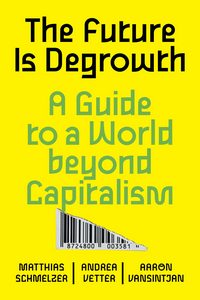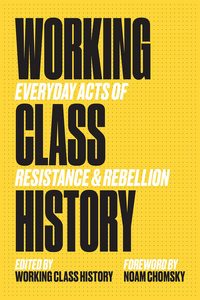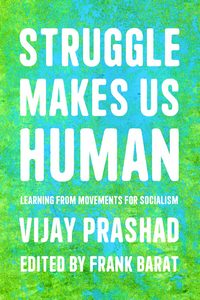Book reviews: Schmelzer, Vetter and Vansintjan / Working Class History / Vijay Prashad
Is This Enough?
 The Future Is Degrowth: a Guide to a World Beyond Capitalism. Matthias Schmelzer, Andrea Vetter and Aaron Vansintjan. Verso £18.99.
The Future Is Degrowth: a Guide to a World Beyond Capitalism. Matthias Schmelzer, Andrea Vetter and Aaron Vansintjan. Verso £18.99.
Degrowth – also referred to as post-growth – can be described as putting an end to economic growth in the conventional capitalist sense and replacing it with sustainable methods of production (for more information, see degrowth.info and degrowth.org). This is an expanded version of a book originally published in German; it surveys the sizeable academic and activist literature on the subject, and examines a range of possible alternatives.
Under capitalism, growth is usually seen in terms of increase in gross domestic product, but there are a number of problems with GDP. It does not examine how useful the products and services it measures are, and it has no room for unpaid labour, such as voluntary work and much care work. Growth is fundamental to capitalism, but is criticised here on various grounds, having led to the catastrophes of global heating, species extinction and genocide of indigenous peoples. Growth destroys the environmental foundations of life, is based on exploitation, devalues reproductive work and relies on domination of ‘developing’ countries by the ruling class in the wealthy countries. Degrowth, however, does not mean recession and austerity: rather, it can open the way to a world of equality and ecological justice.
At the very least, degrowth would probably include use of renewable energy and use of longer-lasting consumer products. The authors recognise that degrowth is not a blueprint, rather it is ‘a broad set of principles and ideas, a path whose twists and turns have yet to be taken’. It is promising that they refer to News from Nowhere and The Dispossessed as depictions of moneyless stateless societies, but other views set out here are not so radical. They discuss Universal Basic Income, and also advocate that such goods and services as housing, food, energy and healthcare ‘be made available to all regardless of the current rate of economic growth or individual income’. But they also refer to ‘the creation of a democratic international monetary system’ and ‘a non-capitalist market economy’. All this reflects the varied views found in the degrowth literature, but it does suggest that what is envisaged is not truly ‘a world beyond capitalism’.
For socialists, the book provokes some interesting ideas. We cannot say now what would happen in terms of degrowth in a socialist world, though we can agree that caring for the environment will be a central concern. Initially, a lot of effort would have to be put into providing food, housing and so on for the global population, and this could at least in part be met by using resources and labour now employed in the money system and the military. In the medium to longer term, there will need to be a balance between satisfying human need and taking account of ecological issues, and growth vs degrowth may well be one issue discussed and debated at length. A society based on common ownership and production for use will surely be the best framework for addressing such questions.
PB
Hidden Histories
 Working Class History. Everyday Acts of Resistance and Rebellion.Edited by Working Class History. PM Press, 2020. 328pp.
Working Class History. Everyday Acts of Resistance and Rebellion.Edited by Working Class History. PM Press, 2020. 328pp.
This book, described as a ‘history of grassroots movements’, goes through all 366 days of the year picking out and briefly summarising either one or two events that have taken place on each of these days in the last 200 years or more in which workers (or peasants) have in some shape or form rebelled against their masters. It does not claim to record all such events, but simply to ‘give a snapshot of the people and movements that have helped improve our world’ and to ‘counter dominant narratives that sanitize the history of capitalism and colonialism’. Given that several hundred of these are recorded, this does not present itself as a cover-to-cover read but rather a book to be dipped in and out of as the reader sees fit.
From the earliest stages of capitalism, workers began to unite in voluntary organisations to negotiate the built-in antagonism of interests between themselves and their employers. The idea was to resist the pressure of the capitalist class on workers’ pay and conditions and to enable workers to get as good a deal as possible (a larger share of ‘surplus value’) in selling their energies and skills to employers. Some examples recorded here, many of them little known, are: the mutiny (successful) of sailors of 15 Royal Navy ships in Plymouth to demand improved pay and conditions (April 26, 1797); the strike (unsuccessful) of 5,000 female cotton mill workers in Pittsburgh for a maximum ten-hour workday and an end to child labour (September 15, 1845); the walk-out (successful) by 1,400 women and girls at the Bryant and May factory in East London in solidarity with a worker fired for criticising appalling working conditions (July 5, 1888); the setting up of the Union of Rural Workers in Hungary which enrolled 75,000 members but was then banned after strike action (December 13, 1905); the strike by black African railway workers across the whole of French West Africa lasting 6 months and leading to numerous concessions from the employer (October 10, 1947); a Maori land occupation near Auckland which was attacked by police, who evicted the protesters, arrested many people and demolished buildings (May 25, 1978); a two-month occupation by 150 mainly female garment workers of Mansoura-Espaňa textile factory in Egypt leading to concessions on job losses and unpaid wages (April 21, 2007).
As can be seen from these examples, these largely untold stories (often reinforced here with stark images) present themselves as anything but simple triumphalism. There are certainly instances of relatively successful attempts to resist oppression or exploitation by workers or peasants but also details of many failed actions and of violence and atrocities carried out by the authorities or by the rich and powerful to counter or crush protests. Indeed the book warns of the ‘disturbing nature of much people’s history’ and that many entries ‘include descriptions of violence, racism, genocide, homophobia, torture and death, and some of them include mentions of sexual violence’.
This panoramic compendium of acts of resistance is accompanied by a foreword by Noam Chomsky and a brief introduction by the compilers of the Working Class History project. Chomsky sees it as part of the fightback for an area of study – labour history – that has been ‘virtually effaced’ in the American educational system and part of the lifting of a ‘veil from central parts of history that had been concealed or sidelined in the standard patriotic version’. The book’s introduction is notable for something rarely found in discussion of ‘class’ in society, that is it supplies a clear and correct definition of ‘working class’. There is no imaginary ‘middle class’ mentioned here but the working class described as referring ’to those of us who do not own factories, farms, offices or stocks therein (also known as “means of production”) and so need to sell our ability to work to people who do’. So we have the class struggle front and centre here, ‘history from below’ in its true sense. The introduction is also effective in highlighting the ‘myriad of ways’ in which the capitalist system seeks to divide workers (eg, employed v unemployed, one nation against another, ‘natives’ against ‘migrants’), to prevent them from uniting to exert their potential power.
It should be added, however, that most of the ‘hidden histories’ recorded here do not arise from the idea of transcending the class divide, ie, doing away altogether with paid employment and the employer-employee relationship and establishing the classless free access society that socialism must be. They are rather understandable (and often courageous) attempts by workers to resist the downward pressure on their pay and working conditions and if possible to make their conditions of life less harsh. The next step in human history is of course for workers to go beyond workplace resistance and beyond single-issue social protest or demands for ‘social justice’, and to organise, as Chomsky has it (and as is the goal of the Socialist Party), ‘to change popular consciousness and understanding’.
HKM
Movements for socialism?
 Struggle Makes Us Human. Learning from Movements for Socialism. By Vijay Prashad. Edited by Frank Barat. Haymarket Books. 2022. 162pp.
Struggle Makes Us Human. Learning from Movements for Socialism. By Vijay Prashad. Edited by Frank Barat. Haymarket Books. 2022. 162pp.
‘An incisive and inspiring call to look beyond capitalism and chart a road map for a planet ravaged by pandemic, climate crises, and wars’. This is how this book, made up of a conversation between two long-term left-wing activists, Vijay Prashad and Frank Barat, is described on its back cover. It takes the form of a series of brief questions by Barat on a wide range of subjects followed by answers at some length by Prashad. Subjects include ‘The capitalist use of crisis’, ‘Resistance and rebellion’, ‘The real meaning of unemployment’, ‘History is a series of experiments’, ‘Transition to the future’, ‘Confidence comes from building movements’, ‘The long effect of the fall of the Soviet Union’, ‘Utopia is not a place but a project’. One of its main concerns, as suggested by the book’s title, is to examine and evaluate what are seen by Prashad as ‘movements for socialism’, those having taken place historically and others taking place now. So he traces, for example, in broad brush strokes and largely admiringly, the Haitian Peasant Revolution of 1804, the Paris Commune, the Bolshevik Revolution leading to the Soviet Union, the Vietnam War, Castro’s Cuba, the Venezuela of Chavez and Maduro, and modern Kerala, referring to them all as ‘pro-people’ movements. But can all or any of these truly be called ‘movements for socialism’?
There is no doubt that some of them at least can only elicit admiration for the attempts they constitute to combat naked oppression and to move the status quo in a progressive direction. But others not so. The Bolshevik state, for example, authoritarian and oppressive from its very beginnings, bore no relation to socialism (a democratically organised stateless and leaderless society of free access to all goods and services). In the same way, Cuba, Vietnam, China and Venezuela, all of which the author is a strong supporter of, are essentially ‘top-down’ regimes integrated into the world capitalism system of markets, trade, money and wages, buying and selling. And they are more oppressive than more ‘liberal’ capitalist states in that they keep a closer check on their populations and in some cases don’t even offer them meaningful elections to vote in. The book puts the poor economic conditions in some of these countries (eg, Venezuela) down to political plotting and economic pressure by the Western powers (‘immense sanctions and hybrid war’), in particular the US. And any view of them as autocratic and oppressive is said to be ‘a fiction of the information war’ against countries which are said to be ‘socialist experiments’. However, whereas the US government may indeed see it in its interests to disparage a country like Venezuela as much as possible, there is still a patent blindness on the part of Prashad and others with similar views, to the manifestly oppressive, kleptocratic nature of the Maduro regime. It cannot just be the influence of America that has caused 6.8 million out of Venezuela’s population of 28 million to flee the country in recent years.
Kerala, on the other hand, a state in Prashad’s native India, governed by a left-wing coalition which the author also lauds, is clearly rather different. It has a government democratically elected and much more representative than places like Cuba or Venezuela, and it has a more advanced capitalist economy than almost anywhere on the Indian sub-continent. Yet the fact that its government is left-wing and may claim to be socialist does not, in any sense, make it some kind of experiment in socialist organisation, or as Prashad would have it, ‘a socialist state project’. At best it is a more advanced, less oppressive and arguably more humane form of capitalist administration than found in most other parts of the Asian continent.
Two sections of this book deal specifically with the future as seen through the author’s lens (‘The Future is Here’ and ‘The Future Will Contain What You Put into It Now’). They talk about ways forward but limit themselves to what can only be described as small beer, suggesting such things as ‘cooperatives’, ‘neighbourhood committees’ and ‘land reclamation’ as well as referring admiringly to the ‘universal housing planning’ of the former USSR and proposing that medicines, food and education should be ‘non-commodified’. A truly utopian wish, this last one, within the framework of capitalism and something again that could only happen in the context of a complete change in the structure of society to free access rather than buying and selling on the market. All the more surprising this, as Prashad is an acute observer and often good at providing incisive commentary into the workings of the capitalism system. His comments on the atomising effects of ‘platform capitalism’ for example, are apt and thought-provoking, as is his analysis of the predatory workings of the IMF and, as a kind of case study, the way in which the mining of copper for iPhones by children in Zambia affects the lives of those children and how that copper then does various commodity journeys around the globe to be transformed into smartphones and packaged for sale. But rather than the ‘impassioned and studied case for socialism’, claimed in ‘praise’ comments from one of the author’s supporters at the beginning of this book, what we have rather are recipes for reformism (‘to defend the gains of modest reforms and even fight for greater reforms’), a suite of proposals for managing capitalism in a less harsh, more worker-friendly way. All this, though referred to as part of the struggle for socialism, is in fact tinkering at the edges and does not get us any closer to the real qualitative transformation needed to establish a society in which all goods and services are truly ‘non-commodified’, ie, freely accessible to all according to need.
HKM
